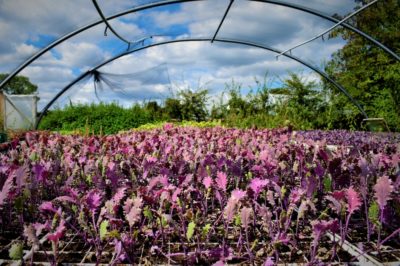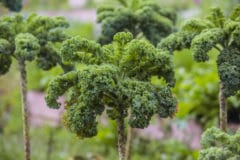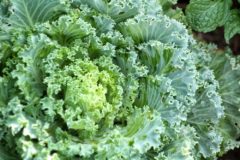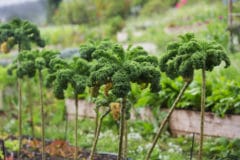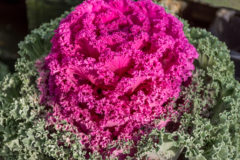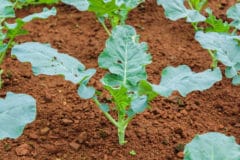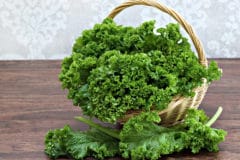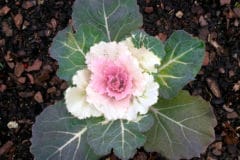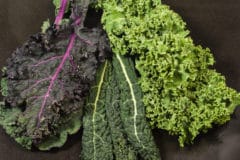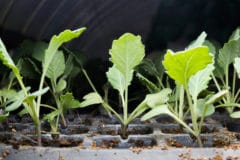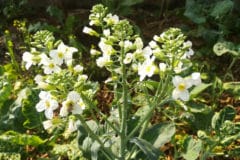How Kale Grows
In general, culinary and ornamental kale leaves grow low to the ground in a cluster around a central stalk. Even the leaves of walking stick kale grow in a cluster, albeit they grow at the top of a tall stalk rather than at the bottom of a low stalk.
Tree kale is encouraged to branch out from its main stalk when it is pruned and that central stalk is topped.
Tree kale and walking stick kale are perennials that live for at least three to five years, but culinary kale is not an annual, as most people think. It is a biennial that lives for two years.
If left in the ground to overwinter, culinary kale will begin growing leaves again in the spring, and, if the weather doesn’t warm up too much in the middle of winter or too quickly in the spring, it may provide a few early spring harvests.
Once culinary kale has overwintered, though, it is ready to bolt, or flower and produce seed. When it begins to bolt, the leaves become bitter and much tougher. The florets are edible though, and once the seed pods have dried, you can open them and collect your own kale seed.
Tree kale and walking stick kale rarely bolt, but if they do, they flower, produce seed, and die out just as culinary kale does. The seeds produced by these two kales may not grow true to their variety, however, so they are grown from cuttings.
Kale’s Preferences
While tree kale and walking stick kale tolerate warmer climates and a wider range of soil types than other kales, most types of kale have the same general environmental preferences as well as similar growth patterns. In general, kale likes:
- Full to partial sun.
- Loamy or sandy soil with a pH between 5.5 and 6.8.
- Well-drained spaces without mud or puddles.
- Soil that retains moisture at depths below 1 inch.
Keep these points in mind when choosing a location for your kale.
When to Plant Kale
When you plant your kale depends on when you want it to be at its peak.
Planting Ornamental or Culinary Kale for Fall
- If you want culinary kale for cold weather harvesting or ornamental kale for your fall flowerbeds and you want to start it from seeds, you should plant your seeds six to 10 weeks before the first frost date in your area.
- Whether you purchase seedlings or start them yourself from seeds, you can plant them as soon as the hottest summer weather passes. You should plant them at least one to two weeks before the first frost date for your area.
Planting Culinary Kale for Spring
- If you are starting culinary kale seedlings from seed for spring harvesting, you should plant your seeds five to seven weeks before the last frost date for your area.
- Whether you have started your own seedlings or purchased them, you should transplant your seedlings one to two week before the last frost date.
- If you are planting seeds outdoors for spring harvesting, you should plant them two to four weeks before the last frost date in your area.
If you don’t know the first and last frost dates for your area, check with your local extension service.
Planting Kale in Containers for Growing Outdoors, Indoors, or Transplanting
If you are growing your kale outdoors in containers, the same timing guidelines apply.
If you are growing your kale indoors, you can plant it at anytime.
Keep in mind, though, that, whenever you plant kale seeds indoors, whether you are growing your kale indoors or you plan to transplant your seedlings outdoors, kale seeds require temperatures to remain between 40°F (4°C) and 70°F (21°C) in order to germinate. Consequently, you will need to keep your seeds in a cool place.
Kale seeds also require light to germinate, so, while you should cover culinary kale seeds with 1/4 inch to 1/2 inch of soil, you should not cover ornamental kale seeds. Cool white fluorescent lights provide a good balance across the light spectrum for starting seeds without adding heat, but adding high intensity LED lights at the red end of the spectrum will encourage the development of the root systems.
Planting Tree Kale
Tree kale seeds do not grow true to their variety, so tree kale needs to be grown from cuttings. The best time to take cuttings from tree kale is in the winter, but the best time to transplant cuttings outdoors is in the early spring.
Cuttings can be taken from the main stem or the branches. The end closest to the roots of the tree should be cut flat and the other end should be cut to form a point. Cuttings should be 6 to 8 inches long with at least six growth nodes or leaf scars.
You can plant tree kale in nursery containers or large coffee cans or yogurt containers with holes punched in the boom for drainage. When planting, cut about an inch off of the flat end, making the cut just below a growing node.
Place the cutting in the soil vertically with the flat end down and approximately one-fourth of the cutting above the top of the soil. At least three nodes should be above the top of the soil and at least three should be below the soil.
Your cuttings should have developed a root system that is sufficient for replanting in four to six weeks, but you can wait for as long as four months before transplanting.
Planting Walking Stick Kale
Some have grown walking stick kale from seed, and some have grown it from cuttings. Follow the guidelines for growing kale from seed or cuttings, depending on which one you have.
The instructions for encouraging walking stick kale to grow and harden the shape of its own hook handle requires planting it in the fall to allow the drier air of winter to help in the hardening process. If you are growing it to harvest the leaves, though, spring planting allows you to enjoy your harvest that much sooner.
Spacing and Thinning Kale
While spacing ornamental, tree, and walking stick kale is standard, how culinary kale is spaced depends on whether it is being grown as sprouts, baby kale, or mature kale.
With the exception of seeds grown for kale sprouts, kale seeds should be planted 1 inch apart and thinned after the true leaves appear.
When you grow kale from seed, the first two leaves you will see are not true leaves. They are the cotyledon, and they are part of the seed, just like the tiny plant that you see between the halves of a roasted peanut. They provide nourishment for the plant until the true leaves form.
When transplanting kale grown from seeds, you should wait until it is about 4 to 6 inches tall with at least four true leaves and two more true leavers forming.
Spacing Kale Sprouts
When planting seeds to grow kale sprouts, you actually harvest the cotyledons. For that reason, you can pack the seeds tightly together so that the plants create a carpet of leaves across the container.
Spacing Baby Kale
When you harvest baby kale, you are harvesting the smallest, most tender, sweetest tasting leaves before they have a chance to grow very large, so the plants can be very close together. Outdoors, plant your seedlings in rows that are 3 to 4 inches apart.
Spacing Mature Culinary Kale
If you are growing your seedlings indoors for later transplanting, thin them to 12 inches apart. Because culinary kale can grow to be 2 to 4 feet high and up to 2 feet across, plant or thin your outdoor seedlings to 12 to 18 inches apart and space the rows 18 inches apart.
Spacing Ornamental Kale
Because ornamental kale grows to no more then 12 inches across and 15 inches high, space the plants about 12 inches apart.
Spacing Kale Grown in a Container
Depending on whether you are growing a dwarf or full size variety, container grown kale can be thinned to 6 to 12 inches apart.
Spacing for Tree Kale and Walking Stick Kale
In a high density planting, tree kale can be grown as close as 12 inches apart, but if you prefer a larger tree with larger leaves, space the plants 20 inches apart.
Walking stick kale should be spaced 40 inches apart.
Harvesting Kale
For culinary and ornamental kale, the central cluster of leaves at the top of the stalk is key to continued growth. So, when harvesting leaves from culinary kale, tree kale, and walking stick kale, leave at least six to eight leaves in place on the central stalk.
In general, mature culinary kale leaves are ready for harvesting when they are about the size of your hand.
For tree kale, only harvest the leaves that are 60 percent green and 40 percent purple, and only harvest about one-third of the leaves on the side branches.
When harvesting any type of kale, snap the leaves down gently but firmly to avoid stripping the leaf down the stalk.
